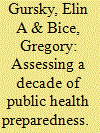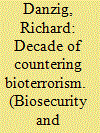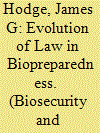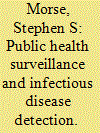|
|
|
Sort Order |
|
|
|
Items / Page
|
|
|
|
|
|
|
| Srl | Item |
| 1 |
ID:
126175


|
|
|
|
|
| Publication |
2012.
|
| Summary/Abstract |
September 11 and the subsequent anthrax attacks marked the beginning of significant investment by the federal government to develop a national public health emergency response capability. Recognizing the importance of the public health sector's contribution to the burgeoning homeland security enterprise, this investment was intended to convey a "dual benefit" by strengthening the overall public health infrastructure while building preparedness capabilities. In many instances, federal funds were used successfully for preparedness activities. For example, electronic health information networks, a Strategic National Stockpile, and increased interagency cooperation have all contributed to creating a more robust and prepared enterprise. Additionally, the knowledge of rarely seen or forgotten pathogens has been regenerated through newly established public health learning consortia, which, too, have strengthened relationships between the practice and academic communities. Balancing traditional public health roles with new preparedness responsibilities heightened public health's visibility, but it also presented significant complexities, including expanded lines of reporting and unremitting inflows of new guidance documents. Currently, a rapidly diminishing public health infrastructure at the state and local levels as a result of federal budget cuts and a poor economy serve as significant barriers to sustaining these nascent federal public health preparedness efforts. Sustaining these improvements will require enhanced coordination, collaboration, and planning across the homeland security enterprise; an infusion of innovation and leadership; and sustained transformative investment for governmental public health.
|
|
|
|
|
|
|
|
|
|
|
|
|
|
|
|
| 2 |
ID:
126220


|
|
|
|
|
| Publication |
2012.
|
| Summary/Abstract |
This research follows the Updated Guidelines for Evaluating Public Health Surveillance Systems, Recommendations from the Guidelines Working Group, published by the Centers for Disease Control and Prevention nearly a decade ago. Since then, models have been developed and complex systems have evolved with a breadth of disparate data to detect or forecast chemical, biological, and radiological events that have a significant impact on the One Health landscape. How the attributes identified in 2001 relate to the new range of event-based biosurveillance technologies is unclear. This article frames the continuum of event-based biosurveillance systems (that fuse media reports from the internet), models (ie, computational that forecast disease occurrence), and constructs (ie, descriptive analytical reports) through an operational lens (ie, aspects and attributes associated with operational considerations in the development, testing, and validation of the event-based biosurveillance methods and models and their use in an operational environment). A workshop was held in 2010 to scientifically identify, develop, and vet a set of attributes for event-based biosurveillance. Subject matter experts were invited from 7 federal government agencies and 6 different academic institutions pursuing research in biosurveillance event detection. We describe 8 attribute families for the characterization of event-based biosurveillance: event, readiness, operational aspects, geographic coverage, population coverage, input data, output, and cost. Ultimately, the analyses provide a framework from which the broad scope, complexity, and relevant issues germane to event-based biosurveillance useful in an operational environment can be characterized.
|
|
|
|
|
|
|
|
|
|
|
|
|
|
|
|
| 3 |
ID:
126164


|
|
|
|
|
| Publication |
2012.
|
| Summary/Abstract |
The fear and disruption caused by the 2001 anthrax attacks understandably led Americans to seek enhanced biodefenses. However, the path followed since those attacks has left the country inadequately prepared to face further risks from biological attacks. Why has security against these threats been only partially achieved? This article suggests that our responses over the past decade can be sorted into 4 levels in order of increasing difficulty. First, we rapidly appropriated funds, augmented personnel, and mandated reorganization of agencies. Though not easy to accomplish, these steps were easily conceptualized and, whatever their imperfections, could rather assuredly be achieved. A second level was more demanding, but also quite achievable. It involved the amplification of ongoing efforts. These efforts sometimes suffered as they scaled up, but, though they were qualified by delays and uncertainties, we can point to real achievements at this level. A third level was more difficult: It required evolving new strategies to deal with this largely unprecedented problem. In this regard, we have so far had only glimmers of possibility. At a fourth level, our performance and our prospects are worse still. At this level, our problems stem from resistances inherent in our country's cultural and political framework. This article identifies some of these problems and suggests, regrettably, that they are not likely to be resolved until change is catalyzed by further, and more dramatically traumatic, attacks or natural disasters. If this situational assessment is correct, what remedial strategies should we pursue? The article distinguishes 3 strategic approaches: an evolutionary one in which the U.S. continues advancing along its present path; a radical approach that attempts to address the fourth-level issues; and a third approach that prepares for punctuated evolution. This third approach accepts the improbability of level 4 change either by gradual evolution or by radical argument, but asserts that it is possible to lay the conceptual groundwork now for the radical changes that will be possible, even demanded, after a catastrophic incident. This approach, neglected at present, would be a valuable addition to our present efforts.
|
|
|
|
|
|
|
|
|
|
|
|
|
|
|
|
| 4 |
ID:
126218


|
|
|
|
|
| Publication |
2012.
|
| Summary/Abstract |
Decontaminating civilian facilities or large urban areas following an attack with Bacillus anthracis poses daunting challenges because of the lack of resources and proven technologies. Nevertheless, lessons learned from the 2001 cleanups together with advances derived from recent research have improved our understanding of what is required for effective decontamination. This article reviews current decontamination technologies appropriate for use in outdoor environments, on material surfaces, within large enclosed spaces, in water, and on waste contaminated with aerosolized B. anthracis spores.
|
|
|
|
|
|
|
|
|
|
|
|
|
|
|
|
| 5 |
ID:
126219


|
|
|
|
|
| Publication |
2012.
|
| Summary/Abstract |
Effective communication and coordination are critical when investigating a possible drinking water contamination incident. A contamination warning system is designed to detect water contamination by initiating a coordinated, effective response to mitigate significant public health and economic consequences. This article describes historical communication barriers during water contamination incidents and discusses how these barriers were overcome through the public health surveillance component of the Cincinnati Drinking Water Contamination Warning System, referred to as the "Cincinnati Pilot." By enhancing partnerships in the public health surveillance component of the Cincinnati Pilot, information silos that existed in each organization were replaced with interagency information depots that facilitated effective decision making.
|
|
|
|
|
|
|
|
|
|
|
|
|
|
|
|
| 6 |
ID:
126159


|
|
|
|
|
| Publication |
2012.
|
| Summary/Abstract |
The decade following the terrorist attacks on September 11, 2001, and ensuing anthrax exposures that same fall has seen significant legal reforms designed to improve biopreparedness nationally. Over the past 10 years, a transformative series of legal changes have effectively (1) rebuilt components of federal, state, and local governments to improve response efforts; (2) created an entire new legal classification known as "public health emergencies"; and (3) overhauled existing legal norms defining the roles and responsibilities of public and private actors in emergency response efforts. The back story as to how law plays an essential role in facilitating biopreparedness, however, is pocked with controversies and conflicts between law- and policymakers, public health officials, emergency managers, civil libertarians, scholars, and others. Significant legal challenges for the next decade remain. Issues related to interjurisdictional coordination; duplicative legal declarations of emergency, disaster, and public health emergency; real-time legal decision making; and liability protections for emergency responders and entities remain unresolved. This article explores the evolving tale underlying the rise and prominence of law as a pivotal tool in national biopreparedness and response efforts in the interests of preventing excess morbidity and mortality during public health emergencies.
|
|
|
|
|
|
|
|
|
|
|
|
|
|
|
|
| 7 |
ID:
126242


|
|
|
|
|
| Publication |
2012.
|
| Summary/Abstract |
Since 2001, the United States government has spent substantial resources on preparing the nation against a bioterrorist attack. Earlier articles in this series have analyzed civilian biodefense funding by the federal government for fiscal years (FY) 2001 through proposed funding for FY2012. This article updates those figures with budgeted amounts for FY2013, specifically analyzing the budgets and allocations for civilian biodefense at the Departments of Health and Human Services, Defense, Homeland Security, Agriculture, Commerce, and State; the Environmental Protection Agency; and the National Science Foundation. As in previous years, our analysis indicates that the majority (>90%) of the "biodefense" programs included in the FY2013 budget have both biodefense and non-biodefense goals and applications-that is, programs to improve infectious disease research, public health and hospital preparedness, and disaster response more broadly. Programs that focus solely on biodefense represent a small proportion (<10%) of our analysis, as the federal agencies continue to prioritize all-hazards preparedness. For FY2013, the federal budget for programs focused solely on civilian biodefense totals $574.2 million, and the budget for programs with multiple goals and applications, including biodefense, is $4.96 billion, for an overall total of $5.54 billion.
|
|
|
|
|
|
|
|
|
|
|
|
|
|
|
|
| 8 |
ID:
126195


|
|
|
|
|
| Publication |
2012.
|
| Summary/Abstract |
Over the past decade, assumptions have been made and unmade about what officials can expect of average people confronting a bioterrorist attack or other major health incident. The reframing of the public in national discourse and doctrine from a panic-stricken mob to a band of hearty survivors is a positive development and more realistic in terms of the empirical record. So, too, is the realization that citizen contributions to national health security encompass not only individual preparedness and volunteerism but also mutual aid and collective deliberation of the tough choices posed by health disasters. In projecting what needs to occur over the next 10 years in biosecurity, 2 priority challenges emerge: retaining the lesson that a public prone to panic, social disorder, and civil unrest is a myth, and building an infrastructure to bolster the public's full contributions to health emergency management.
|
|
|
|
|
|
|
|
|
|
|
|
|
|
|
|
| 9 |
ID:
126241


|
|
|
|
|
| Publication |
2012.
|
| Summary/Abstract |
In June and July 2010, we conducted a national internet-based survey of 64 city, state, and territorial immunization program managers (IPMs) to assess their experiences in managing the 2009-10 H1N1 influenza vaccination campaign. Fifty-four (84%) of the managers or individuals responsible for an immunization program responded to the survey. To manage the campaign, 76% indicated their health department activated an incident command system (ICS) and 49% used an emergency operations center (EOC). Forty percent indicated they shared the leadership of the campaign with their state-level emergency preparedness program. The managers' perceptions of the helpfulness of the emergency preparedness staff was higher when they had collaborated with the emergency preparedness program on actual or simulated mass vaccination events within the previous 2 years. Fifty-seven percent found their pandemic influenza plan helpful, and those programs that mandated that vaccine providers enter data into their jurisdiction's immunization information system (IIS) were more likely than those who did not mandate data entry to rate their IIS as valuable for facilitating registration of nontraditional providers (42% vs. 25%, p<0.05) and tracking recalled influenza vaccine (50% vs. 38%, p<0.05). Results suggest that ICS and EOC structures, pandemic influenza plans, collaborations with emergency preparedness partners during nonemergencies, and expanded use of IIS can enhance immunization programs' ability to successfully manage a large-scale vaccination campaign. Maintaining the close working relationships developed between state-level immunization and emergency preparedness programs during the H1N1 influenza vaccination campaign will be especially important as states prepare for budget cuts in the coming years.
|
|
|
|
|
|
|
|
|
|
|
|
|
|
|
|
| 10 |
ID:
126143


|
|
|
|
|
| Publication |
2012.
|
| Summary/Abstract |
The dual-use dilemma in the life sciences-that illicit applications draw on the same science and technology base as legitimate applications-makes it inherently difficult to control one without inhibiting the other. Since before the September 11 attacks, the science and security communities in the United States have struggled to develop governance processes that can simultaneously minimize the risk of misuse of the life sciences, promote their beneficial applications, and protect the public trust. What has become clear over that time is that while procedural steps can be specified for assessing and managing dual-use risks in the review of research proposals, oversight of ongoing research, and communication of research results, the actions or decisions to be taken at each of these steps to mitigate dual-use risk defy codification. Yet the stakes are too high to do nothing, or to be seen as doing nothing. The U.S. government should therefore adopt an oversight framework largely along the lines recommended by the National Science Advisory Board for Biosecurity almost 5 years ago-one that builds on existing processes, can gain buy-in from the scientific community, and can be implemented at modest cost (both direct and opportunity), while providing assurance that a considered and independent examination of dual-use risks is being applied. Without extraordinary visibility into the actions of those who would misuse biology, it may be impossible to know how well such an oversight system will actually succeed at mitigating misuse. But maintaining the public trust will require a system to be established in which reasonably foreseeable dual-use consequences of life science research are anticipated, evaluated, and addressed.
|
|
|
|
|
|
|
|
|
|
|
|
|
|
|
|
| 11 |
ID:
126128


|
|
|
|
|
| Publication |
2012.
|
| Summary/Abstract |
Emerging infectious diseases, such as HIV/AIDS, SARS, and pandemic influenza, and the anthrax attacks of 2001, have demonstrated that we remain vulnerable to health threats caused by infectious diseases. The importance of strengthening global public health surveillance to provide early warning has been the primary recommendation of expert groups for at least the past 2 decades. However, despite improvements in the past decade, public health surveillance capabilities remain limited and fragmented, with uneven global coverage. Recent initiatives provide hope of addressing this issue, and new technological and conceptual advances could, for the first time, place capability for global surveillance within reach. Such advances include the revised International Health Regulations (IHR 2005) and the use of new data sources and methods to improve global coverage, sensitivity, and timeliness, which show promise for providing capabilities to extend and complement the existing infrastructure. One example is syndromic surveillance, using nontraditional and often automated data sources. Over the past 20 years, other initiatives, including ProMED-mail, GPHIN, and HealthMap, have demonstrated new mechanisms for acquiring surveillance data. In 2009 the U.S. Agency for International Development (USAID) began the Emerging Pandemic Threats (EPT) program, which includes the PREDICT project, to build global capacity for surveillance of novel infections that have pandemic potential (originating in wildlife and at the animal-human interface) and to develop a framework for risk assessment. Improved understanding of factors driving infectious disease emergence and new technological capabilities in modeling, diagnostics and pathogen identification, and communications, such as using the increasing global coverage of cellphones for public health surveillance, can further enhance global surveillance
|
|
|
|
|
|
|
|
|
|
|
|
|
|
|
|
| 12 |
ID:
126209


|
|
|
|
|
| Publication |
2012.
|
| Summary/Abstract |
The use of tabletop exercises as a tool in emergency preparedness and response has proven to be an effective means of assessing readiness for unexpected events. Whereas most exercise developers target a population in a defined space (eg, state, county, metropolitan area, hospital), the Southeastern Center for Emerging Biologic Threats (SECEBT) conducted an innovative tabletop exercise involving an unusual foodborne outbreak pathogen, targeting public health agencies and academic institutions in 7 southeastern states. The exercise tested the ability of participants to respond to a simulated foodborne disease outbreak affecting the region. The attendees represented 4 federal agencies, 9 state agencies, 6 universities, 1 nonprofit organization, and 1 private corporation. The goals were to promote collaborative relationships among the players, identify gaps in plans and policies, and identify the unique contributions of each organization-and notably academic institutions-to outbreak recognition, investigation, and control. Participants discussed issues and roles related to outbreak detection and management, risk communication, and coordination of policies and responsibilities before, during, and after an emergency, with emphasis on assets of universities that could be mobilized during an outbreak response. The exercise generated several lessons and recommendations identified by participants and evaluators. Key recommendations included a need to establish trigger points and protocols for information sharing and alerts among public health, academic, and law enforcement; to establish relationships with local, state, and federal stakeholders to facilitate communications during an emergency; and to catalogue and leverage strengths, assets, and priorities of academic institutions to add value to outbreak responses.
|
|
|
|
|
|
|
|
|
|
|
|
|
|
|
|
| 13 |
ID:
126215


|
|
|
|
|
| Publication |
2012.
|
| Summary/Abstract |
All of the costs associated with decontamination following the 2001 anthrax letter attacks were summarized, estimated, and aggregated based on existing literature and news media reports. A comprehensive list of all affected structures was compiled. Costs were analyzed by building class and decontamination type. Sampling costs and costs of worker relocation were also included. Our analysis indicates that the total cost associated with decontamination was about $320 million.
|
|
|
|
|
|
|
|
|
|
|
|
|
|
|
|
| 14 |
ID:
126181


|
|
|
|
|
| Publication |
2012.
|
| Summary/Abstract |
The U.S. government has taken significant steps toward developing and acquiring vaccines, drugs, and other medical countermeasures (MCMs) to protect and treat the population after a biological attack. In contrast to 2001, there is now a procedure for the Department of Health and Human Services (HHS) to develop, license, and stockpile MCMs for civilian use. Another major accomplishment is smallpox preparedness: There is now an adequate supply of vaccine for every person in the U.S., and there is an alternative vaccine meant for immunocompromised people and those with close contact with them. In spite of these and other accomplishments, the U.S. government MCM effort has been criticized by federal advisory committees, National Academy of Sciences reports, a congressional commission, and outside analysts who state that the efforts lack central leadership and accountability and that the pace of progress has been slow. A clear operational strategy for using MCMs, which would guide their development and acquisition, is also lacking. In this article, we review key areas of progress made since 2001 to develop and acquire MCMs, and we summarize what we judge to be the most critical and often mentioned areas where improvements are needed.
|
|
|
|
|
|
|
|
|
|
|
|
|
|
|
|
|
|
|
|
|